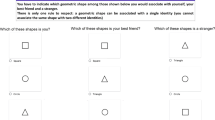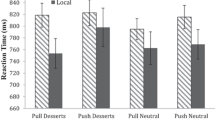Abstract
People prefer curved and symmetrical shapes to their angular and asymmetrical counterparts. While it is known that stimulus valence is central to approach and avoidance motivation, the exact nature of the relationship between curvature/symmetry and approach/avoidance motivation still needs to be clarified. Experiment 1 was designed to investigate whether simple shapes are associated with approach and avoidance words. Participants found it easier to match more symmetrical shapes with approach words. In Experiment 2, symmetry was differentially associated with approach words and was rated significantly higher on the approach dimension than asymmetry. Next, we assessed whether object valence and object curvature (Experiment 3) or symmetry (Experiment 4) would lead to different associations to approach and avoidance words. Only object valence had a significant influence on participants’ ratings, with the positively-valenced objects being more closely associated with approach words than their negatively-valenced counterparts. These results highlight the complex relation between visual properties of objects, their valence, and appetitive and aversive categories.







Similar content being viewed by others
Notes
The hybrid estimation method produces a more robust maximum likelihood estimation of parameters (due to the combination of two traditional optimization methods: Newton-Rampson and Fisher). The interested reader may consult Hardin and Hilbe’s (2012) work for more information concerning GEE.
References
Apthorp, D., & Bell, J. (2015). Symmetry is less than meets the eye. Current Biology, 25, R267–R268. doi:10.1016/j.cub.2015.02.017.
Bar, M., & Neta, M. (2006). Humans prefer curved visual objects. Psychological Science, 17, 645–648. doi:10.1111/j.1467-9280.2006.01759.x.
Bar, M., & Neta, M. (2007). Visual elements of subjective preference modulate amygdala activation. Neuropsychologia, 45, 2191–2200. doi:10.1016/j.neuropsychologia.2007.03.008.
Barca, L., & Pezzulo, G. (2015). Tracking second thoughts: Continuous and discrete revision processes during visual lexical decision. PLoS One, 10, e0116193. doi:10.1371/journal.pone.0116193.
Barrett, L. F. (2006). Valence is a basic building block of emotional life. Journal of Research in Personality, 40, 35–55. doi:10.1016/j.jrp.2005.08.006.
Barrett, L. F., & Bar, M. (2009). See it with feeling: Affective predictions during object perception. Philosophical Transactions of the Royal Society B: Biological Sciences, 364, 1325–1334. doi:10.1098/rstb.2008.0312.
Berridge, K. C. (1996). Food reward: Brain substrates of wanting and liking. Neuroscience and Biobehavioral Reviews, 20, 1–25. doi:10.1016/0149-7634(95)00033-B.
Carbon, C.-C. (2010). The cycle of preference: Long-term dynamics of aesthetic appreciation. Acta Psychologica, 134, 233–244. doi:10.1016/j.actpsy.2010.02.004.
Chatterjee, A. (2014). The aesthetic brain: How we evolved to desire beauty and enjoy art. New York, NY: Oxford University Press.
Chatterjee, A., & Vartanian, O. (2014). Neuroaesthetics. Trends in Cognitive Sciences, 18, 370–375. doi:10.1016/j.tics.2014.03.003.
Cliff, N. (1996). Answering ordinal questions with ordinal data using ordinal statistics. Multivariate Behavioral Research, 31, 331–350. doi:10.1207/s15327906mbr3103_4.
Collier, G. L. (1996). Affective synesthesia: Extracting emotion space from simple perceptual stimuli. Motivation and Emotion, 20, 1–32. doi:10.1007/BF02251005.
Dazkir, S. S., & Read, M. A. (2012). Furniture forms and their influence on our emotional responses toward interior environments. Environment and Behavior, 44, 722–732. doi:10.1177/0013916511402063.
Elliot, A. J., Eder, A. B., & Harmon-Jones, E. (2013). Approach/avoidance motivation and emotion: Convergence and divergence. Emotion Review, 5, 308–311. doi:10.1177/1754073913477517.
Enquist, M., & Arak, A. (1994). Symmetry, beauty and evolution. Nature, 372, 169–172. doi:10.1038/372169a0.
Enquist, M., & Johnstone, R. A. (1997). Generalization and the evolution of symmetry preferences. Proceedings of the Royal Society of London B: Biological Sciences, 264, 1345–1348.
Erceg-Hurn, D. M., & Mirosevich, V. M. (2008). Modern robust statistical methods: An easy way to maximize the accuracy and power of your research. American Psychologist, 63, 591–601. doi:10.1037/0003-066X.63.7.591.
Fetterman, A. K., Ode, S., & Robinson, M. D. (2013). For which side the bell tolls: The laterality of approach/avoidance associative networks. Motivation and Emotion, 37, 33–38. doi:10.1007/s11031-012-9306-5.
Freeman, J. B., & Ambady, N. (2010). MouseTracker: Software for studying real-time mental processing using a computer mouse-tracking method. Behavior Research Methods, 42, 226–241. doi:10.3758/BRM.42.1.226.
Freeman, J. B., Dale, R., & Farmer, T. A. (2011). Hand in motion reveals mind in motion. Frontiers in Psychology, 2, 59. doi:10.3758/BRM.42.1.226.
Gómez-Puerto, G., Munar, E., & Nadal, M. (2016). Preference for curvature: A historical and conceptual framework. Frontiers in Human Neuroscience, 9, 712. doi:10.3389/fnhum.2015.00712.
Gordon, K. (1909). Esthetics. New York, NY: Henry Holt.
Hair, H. I. (1995). Mood categories of lines, colors, words, and music. Bulletin of the Council for Research in Music Education, 127, 99–105.
Hanley, J. A., Negassa, A., de Edwardes, M. D. B., & Forrester, J. E. (2003). Statistical analysis of correlated data using generalized estimating equations: An orientation. American Journal of Epidemiology, 157, 364–375. doi:10.1093/aje/kwf215.
Hardin, J. A., & Hilbe, J. M. (2012). Generalized estimating equations. Boca Raton, FL: Chapman and Hall.
Hopkins, J. R., Kagan, J., Brachfeld, S., Hans, S., & Linn, S. (1976). Infant responsivity to curvature. Child Development, 47, 1166–1171. doi:10.1111/j.1467-8624.1976.tb02300.x.
Jacobsen, T., & Höfel, L. (2003). Descriptive and evaluative judgment processes: Behavioral and electrophysiological indices of processing symmetry and aesthetics. Cognitive, Affective, & Behavioral Neuroscience, 3, 289–299.
Jacobsen, T., Schubotz, R. I., Höfel, L., & Cramon, D. Y. V. (2006). Brain correlates of aesthetic judgment of beauty. NeuroImage, 29, 276–285. doi:10.1016/j.neuroimage.2005.07.010.
Jadva, V., Hines, M., & Golombok, S. (2010). Infants’ preferences for toys, colors, and shapes: Sex differences and similarities. Archives of Sexual Behavior, 39, 1261–1273. doi:10.1007/s10508-010-9618-z.
Jansson, L., Forkman, B., & Enquist, M. (2002). Experimental evidence of receiver bias for symmetry. Animal Behaviour, 63, 617–621. doi:10.1006/anbe.2001.1936.
Jennions, M. D. (1998). The effect of leg band symmetry on female-male association in zebra finches. Animal Behaviour, 55, 61–67. doi:10.1006/anbe.2001.1936.
Kawase, H., Okata, Y., & Ito, K. (2013). Role of huge geometric circular structures in the reproduction of a marine pufferfish. Scientific Reports, 3, 4–8. doi:10.1038/srep02106.
Krieglmeyer, R., Deutsch, R., De Houwer, J., & De Raedt, R. (2010). Being moved: Valence activates approach/avoidance behavior independently of evaluation and approach/avoidance intentions. Psychological Science, 21, 607–613. doi:10.1177/0956797610365131.
Larson, C. L., Aronoff, J., & Steuer, E. L. (2012). Simple geometric shapes are implicitly associated with affective value. Motivation and Emotion, 36, 404–413. doi:10.1007/s11031-011-9249-2.
Leder, H., & Carbon, C.-C. (2005). Dimensions in appreciation of car interior design. Applied Cognitive Psychology, 19, 603–618. doi:10.1002/acp.1088.
Leder, H., Tinio, P. P. L., & Bar, M. (2011). Emotional valence modulates the preference for curved objects. Perception, 40, 649–655. doi:10.1068/p6845.
Liang, K.-Y., & Zeger, S. L. (1986). Longitudinal data analysis using generalized linear models. Biometrika, 73, 13–22. doi:10.1093/biomet/73.1.13.
Lundholm, H. (1921). The affective tone of lines: Experimental researches. Psychological Review, 28, 43–60. doi:10.1037/h0072647.
Magnuson, J. S. (2005). Moving hand reveals dynamics of thought. Proceedings of the National Academy of Sciences of the United States of America, 102, 9995–9996. doi:10.1073/pnas.0504413102.
Møller, A. P. (1990). Fluctuating asymmetry in male sexual ornaments may reliably reveal male quality. Animal Behaviour, 40, 1185–1187. doi:10.1016/S0003-3472(05)80187-3.
Møller, A. P., & Pomiankowski, A. (1993). Why have birds got multiple sexual ornaments? Behavioral Ecology and Sociobiology, 32, 167–176. doi:10.1007/BF00173774.
Munar, E., Gómez-Puerto, G., Call, J., & Nadal, M. (2015). Common visual preference for curved contours in humans and great apes. PLoS One, 10(11), e0141106. doi:10.1371/journal.pone.0141106.
Noguchi, K., Gel, Y. R., Brunner, E., & Konietschke, F. (2012). nparLD: An R software package for the nonparametric analysis of longitudinal data in factorial experiments. Journal of Statistical Software, 50, 1–23. doi:10.18637/jss.v050.i12.
Oakes, E. J., & Barnard, P. (1994). Fluctuating asymmetry and mate choice in paradise whydahs, Vidua paradisaea: An experimental manipulation. Animal Behaviour, 48, 937–943. doi:10.1006/anbe.1994.1319.
Palmer, S. E., Schloss, K. B., & Sammartino, J. (2013). Visual aesthetics and human preference. Annual Review of Psychology, 64, 77–107. doi:10.1146/annurev-psych-120710-100504.
Palumbo, L., Ruta, N., & Bertamini, M. (2015). Comparing angular and curved shapes in terms of implicit associations and approach/avoidance responses. PLoS One, 10(10), e0140043. doi:10.1371/journal.pone.0140043.
Poffenberger, A. T., & Barrows, B. E. (1924). The feeling value of lines. Journal of Applied Psychology, 8, 187–205. doi:10.1037/h0073513.
Reber, R., Schwarz, N., & Winkielman, P. (2004). Processing fluency and aesthetic pleasure: Is beauty in the perceiver’s processing experience? Personality and Social Psychology Review, 8, 364–382. doi:10.1207/s15327957pspr0804_3.
Rodríguez, I., Gumbert, A., De Ibarra, N. H., Kunze, J., & Giurfa, M. (2004). Symmetry is in the eye of the “beeholder”: Innate preference for bilateral symmetry in flower-naïve bumblebees. Naturwissenschaften, 91, 374–377. doi:10.1007/s00114-004-0537-5.
Salgado-Montejo, A., Tapia Leon, I., Elliot, A. J., Salgado, C. J., & Spence, C. (2015). Smiles over frowns: When curved lines influence product preference. Psychology and Marketing, 32, 771–781. doi:10.1002/mar.20817.
Sasaki, Y., Vanduffel, W., Knutsen, T., Tyler, C., & Tootell, R. (2005). Symmetry activates extrastriate visual cortex in human and nonhuman primates. Proceedings of the National Academy of Sciences of the United States of America, 102, 3159–3163. doi:10.1073/pnas.0500319102.
Shen, X., Wan, X., Mu, B., & Spence, C. (2015). Searching for triangles: An extension to food and packaging. Food Quality and Preference, 44, 26–35. doi:10.1016/j.foodqual.2015.03.015.
Shepherd, K., & Bar, M. (2011). Preference for symmetry: Only on Mars? Perception, 40, 1254. doi:10.1068/p7057.
Silvia, P. J. (2009). Looking past pleasure: Anger, confusion, disgust, pride, surprise, and other unusual aesthetic emotions. Psychology of Aesthetics, Creativity, and the Arts, 3, 48–51. doi:10.1037/a0014632.
Silvia, P. J., & Barona, C. M. (2009). Do people prefer curved objects? Angularity, expertise, and aesthetic preference. Empirical Studies of the Arts, 27, 25–42. doi:10.2190/EM.27.1.b.
Spivey, M. J., & Dale, R. (2006). Continuous dynamics in real-time cognition. Current Directions in Psychological Science, 15, 207–211. doi:10.1111/j.1467-8721.2006.00437.x.
Stewart, I. (2013). Symmetry: A very short introduction. Oxford, UK: Oxford University Press.
Thornhill, R., & Gangestad, S. (1999). Facial attractiveness. Trends in Cognitive Sciences, 3, 452–460. doi:10.1016/S1364-6613(99)01403-5.
Tinio, P. P., & Leder, H. (2009). Just how stable are stable aesthetic features? Symmetry, complexity, and the jaws of massive familiarization. Acta Psychologica, 130, 241–250.
Vartanian, O., Navarrete, G., Chatterjee, A., Fich, L. B., Leder, H., Modroño, C., et al. (2013). Impact of contour on aesthetic judgments and approach–avoidance decisions in architecture. Proceedings of the National Academy of Sciences of the United States of America, 110, 10446–10453. doi:10.1073/pnas.1301227110.
Wagemans, J. (1995). Detection of visual symmetries. Spatial Vision, 9, 9–32. doi:10.1163/156856895X00098.
Watson, P. J., & Thornhill, R. (1994). Fluctuating asymmetry and sexual selection. Trends in Ecology and Evolution, 9, 21–25. doi:10.1016/0169-5347(94)90227-5.
Westerman, S. J., Gardner, P. H., Sutherland, E. J., White, T., Jordan, K., Watts, D., & Wells, S. (2012). Product design: Preference for rounded versus angular design elements. Psychology and Marketing, 29, 595–605. doi:10.1002/mar.20546.
Author information
Authors and Affiliations
Corresponding author
Ethics declarations
Human and animal rights
All procedures performed in studies involving human participants were in accordance with the ethical standards of the institutional and/or national research committee and with the 1964 Helsinki declaration and its later amendments or comparable ethical standards.
Additional information
Carlos Velasco and Alejandro Salgado-Montejo have contributed equally to the development of this study.
Rights and permissions
About this article
Cite this article
Velasco, C., Salgado-Montejo, A., Elliot, A.J. et al. The shapes associated with approach/avoidance words. Motiv Emot 40, 689–702 (2016). https://doi.org/10.1007/s11031-016-9559-5
Published:
Issue Date:
DOI: https://doi.org/10.1007/s11031-016-9559-5






